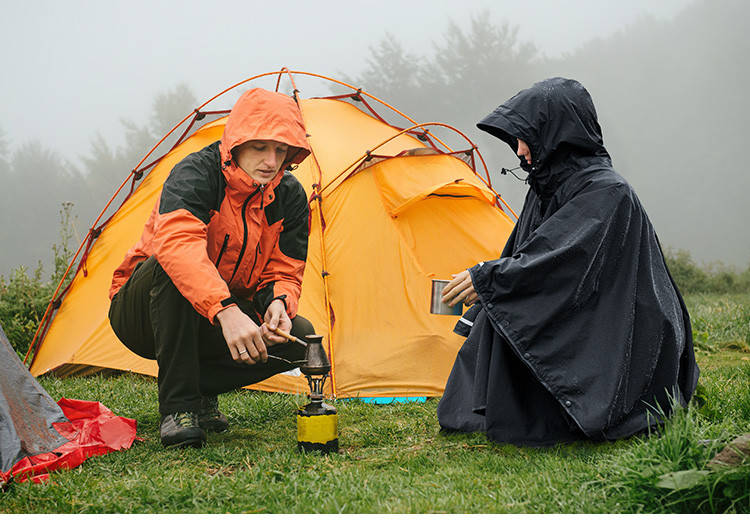You’ve got all your gear ready, picked the perfect destination, and finally convinced your buddies to join you for a camping trip. However, at the last minute, the weather forecast predicts rain for the weekend. While it’s essential to reschedule in case of severe rain or thunderstorms, don’t let rain ruin your entire trip. Remember these 8 tips to turn a rainy camping day into an enjoyable experience.

- Detailed Preparation: Keeping your body dry is crucial to prevent rainwater from seeping into clothes and gear. Use rain covers (despite the name, they come in lightweight versions for rain protection) or wear waterproof pants to prevent water from entering your boots. Wear a baseball cap or other outdoor hats to stop water droplets from getting in through the collar. Bring a few waterproof tarps to create a “roof” and provide a dry space during camping activities.
- Check and Repair Your Gear: Before camping in the rain, inspect tent seams, check for punctures and wear on fabric, and ensure guy lines are in good condition. If there’s damage, purchase the necessary accessories for repairs. Clean old rain jackets, as dirt can clog waterproof membrane pores, reducing breathability. If the DWR (Durable Water Repellent) coating is worn, reapply a waterproof spray. Similarly, even if your hiking boots have internal waterproof membranes, worn-out DWR on the outer layer can compromise water resistance, making the boots heavier and less breathable.
- Pack Smartly: Your backpack rain cover is the first line of defense. Use plastic sealable bags for packing to protect items from water and side rain. Pre-assemble the tent, tie down the guy lines, and fold the rainfly in an easily deployable manner before packing. This speeds up tent setup and minimizes exposure during assembly.
- Dress Appropriately: Clothes can get wet from two sources during outdoor hiking: rain and sweat. Avoid cotton underwear, which is challenging to dry once wet, and opt for quick-drying synthetic fibers or lightweight wool. In areas with light rainfall, consider wearing a softshell jacket to maximize breathability and sweat dispersion. In colder or heavier rain conditions, a hardshell rain jacket is necessary for wind and rain resistance. Modern hardshell jackets with advanced materials provide reliable waterproofing, comfort, and breathability.
- Adopt the Right Posture: During hiking, keep your arms down to prevent rain from infiltrating through sleeves. Tighten your chin to let rain drip off your hat, preventing water from reaching your neck.
- Properly Layer Clothing: A small detail, but it makes a significant impact over time. Tuck in the lower hem and cuffs of your base layers to prevent them from absorbing water, keeping your clothes drier.
- Choose the Right Campsite: Select a well-drained location. Stay away from gullies, low-lying areas, and soft soil where rainwater tends to collect. Opt for a spot under trees or behind large rocks to resist wind and rain.
- Tent Pitching Technique: When pitching a tent, face the smallest side (usually the rear) into the wind to ensure a better night’s sleep. Tighten the rainfly with guy lines, ensuring it extends beyond the tent’s bottom. If the camping area is low, place a ground tarp outside the tent to prevent rain from seeping in from below.
Conclusion: By paying attention to details, preparing your gear, dressing appropriately, and choosing the right campsite and tent pitching technique, you can transform a rainy camping day into a memorable and enjoyable experience. Don’t let a little rain dampen your adventurous spirit!

